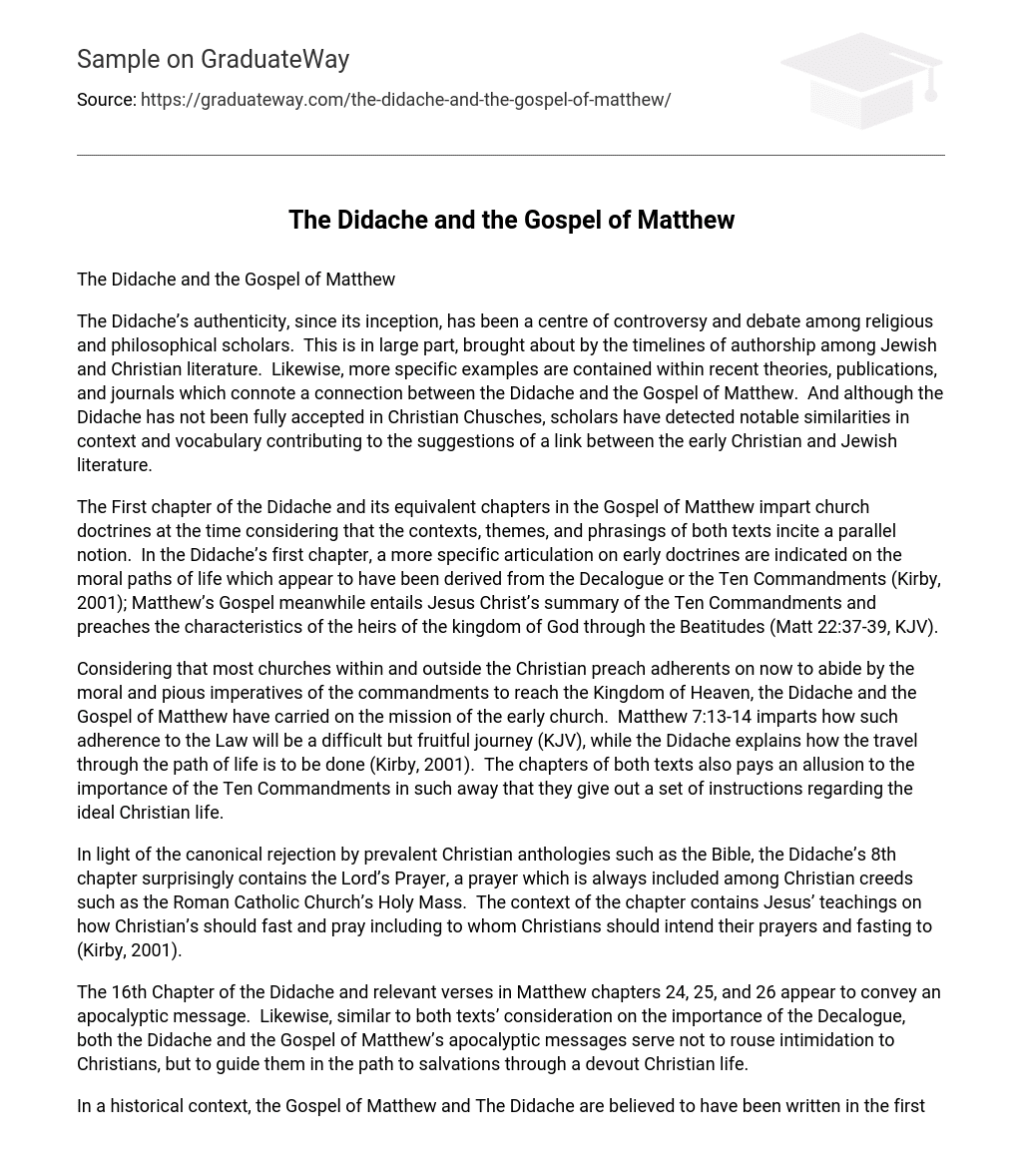The Didache’s authenticity, since its inception, has been a centre of controversy and debate among religious and philosophical scholars. This is in large part, brought about by the timelines of authorship among Jewish and Christian literature. Likewise, more specific examples are contained within recent theories, publications, and journals which connote a connection between the Didache and the Gospel of Matthew. And although the Didache has not been fully accepted in Christian Chusches, scholars have detected notable similarities in context and vocabulary contributing to the suggestions of a link between the early Christian and Jewish literature.
The First chapter of the Didache and its equivalent chapters in the Gospel of Matthew impart church doctrines at the time considering that the contexts, themes, and phrasings of both texts incite a parallel notion. In the Didache’s first chapter, a more specific articulation on early doctrines are indicated on the moral paths of life which appear to have been derived from the Decalogue or the Ten Commandments (Kirby, 2001); Matthew’s Gospel meanwhile entails Jesus Christ’s summary of the Ten Commandments and preaches the characteristics of the heirs of the kingdom of God through the Beatitudes (Matt 22:37-39, KJV).
Considering that most churches within and outside the Christian preach adherents on now to abide by the moral and pious imperatives of the commandments to reach the Kingdom of Heaven, the Didache and the Gospel of Matthew have carried on the mission of the early church. Matthew 7:13-14 imparts how such adherence to the Law will be a difficult but fruitful journey (KJV), while the Didache explains how the travel through the path of life is to be done (Kirby, 2001). The chapters of both texts also pays an allusion to the importance of the Ten Commandments in such away that they give out a set of instructions regarding the ideal Christian life.
In light of the canonical rejection by prevalent Christian anthologies such as the Bible, the Didache’s 8th chapter surprisingly contains the Lord’s Prayer, a prayer which is always included among Christian creeds such as the Roman Catholic Church’s Holy Mass. The context of the chapter contains Jesus’ teachings on how Christian’s should fast and pray including to whom Christians should intend their prayers and fasting to (Kirby, 2001).
The 16th Chapter of the Didache and relevant verses in Matthew chapters 24, 25, and 26 appear to convey an apocalyptic message. Likewise, similar to both texts’ consideration on the importance of the Decalogue, both the Didache and the Gospel of Matthew’s apocalyptic messages serve not to rouse intimidation to Christians, but to guide them in the path to salvations through a devout Christian life.
In a historical context, the Gospel of Matthew and The Didache are believed to have been written in the first century (Harris, 1985), and such beliefs are furthered by evidence supporting the emergence, transmittance, and growth of both writings in a common background (Van de Sandt & Van de Sandt, 2005). Likewise, the Gospel of Matthew follows a similar sequence and wording with the Gospels of Mark and Luke, as such reading through the contents of Matthew and the Didache would likely insinuate an allusion to the Gospel of Luke. Furthermore, both texts also recall the Book of Exodus to the readers because, as previously mentioned, both Matthew and the Didache highlight the importance of the Decalogue in promoting the ideal Christian life.
Based on the respective relevant chapters of the two writings, the Didache and the Gospel of Matthew bequeath that the two texts are influenced by a similar background. In addition, as per the contextual analysis of both the Gospel of Matthew and The Didache, it is plausible to consider that the writings present equally relevant evidence that its authorship is categorized as first century literature.
References
Harris, S. L..( 1985.). Understanding the Bible, Palo Alto: Mayfield.
Kirby, P. (3, September 2008). The Didache: The Lord’s Teaching Through the Twelve Apostles to the Nations. Early Christian Writings. Retrieved September 3, 2008, from http://www.earlychristianwritings.com/text/didache-roberts.html
Van de Sandt, M., & Van de Sandt, H. (2005). Matthew and the Didache: Two Documents from the Same Jewish-christian Milieu? Boston: Brill Academic Publishers.





